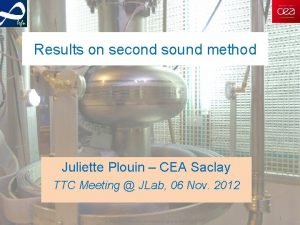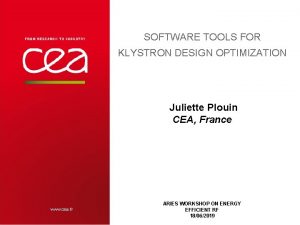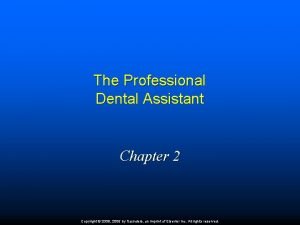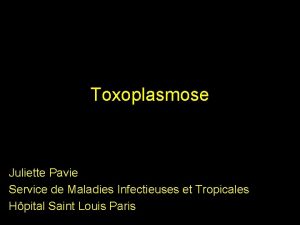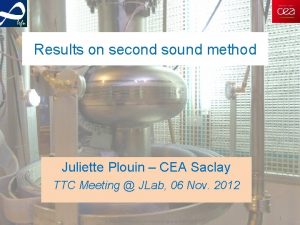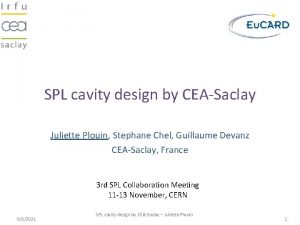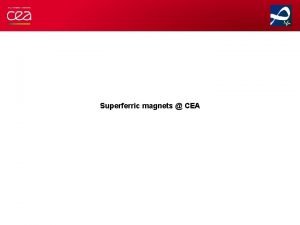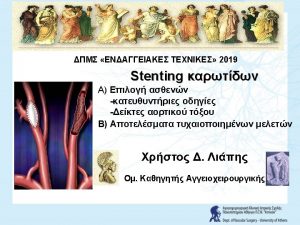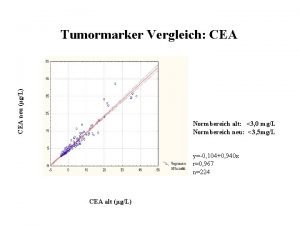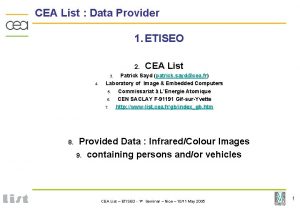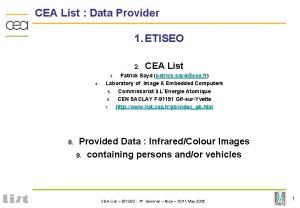Results on second sound method Juliette Plouin CEA














- Slides: 14

Results on second sound method Juliette Plouin – CEA Saclay TTC Meeting @ JLab, 06 Nov. 2012 J. Plouin – Results on second sound method 1

Outline § How to localize a quench spot with 2 nd sound wave propagation § Results at Saclay § Problem of the « too fast » second sound wave § Possible explanation § Perspective at Saclay J. Plouin – Results on second sound method 2

Quench localization by 2 nd sound method Sensor OST 1 RF Sensor OST 2 The RF field is increased in the cavity Sensor quench RF A quench spot appears on the cavity OST 3 • In superfluid helium, heat flux is generated by the quench as a 2 nd sound wave, whose velocity is supposed to be known (~20 m/s) • This 2 nd sound wave is detected by n OST sensors placed around the cavity RF power propagates from • The time of arrival of each of the n the spot into the He signals is measured • The distance between the quench spot and each sensor is calculated (distance=speed*time) • The quench spot localization is determined by triangulation Alternative to temperature mapping. • Only few sensors are necessary in the cryostat • Can only be used in superfluid helium (T < 2, 17 K) J. Plouin – Results on second sound method 3

2 nd sound wave sensors: Oscillating Superleak Transducers Kitty Liao, CERN ð A flexible and porous plate is deformed by the arrival of 2 nd sound wave. ð This results in capacity change between the two plates (fixed and flexible) ð OSTs are polarized by a 120 V, DC, and signal is amplified and filtered by a circuit We got 8 OSTs from Cornell, and should get some more from CERN Cornell CEA J. Plouin – Results on second sound method 4

Tests on a monocell cavity in vertical cryostat at CEA Monocell cavity 1, 3 GHz OSTs Temperature mapping 4 OSTs are placed around the cavity, in the equator plane J. Plouin – Results on second sound method 5

Localization with temperature mapping 30 MV/m azim uth Cavity from top m u r n o ns e S Quench is localized on the equator, between OST#2 and OST#3 J. Plouin – Results on second sound method r be 6

Localization with OSTs Quench OST # 2 OST # 3 OST # 4 Dt 3 OST # 2 Circles with diameters (Dt*20 m/s) are drawn from the 2 nearest OST (nearly in direct sight of quench location) The circles don’t intersect : it looks like a « too fast » 2 nd sound wave ! NB : here the triangulation is made in 2 D, since quench and OSTs are in the same plane) J. Plouin – Results on second sound method OST # 3 7

Triangulation by fonction minimization is built • The velocity v 2 s is used as a parameter and varied • For each v 2 s value, the couple (x, y), minimizing F(x, y) and being on the cavity equator is calculated v = 20 m/s Minimum of F(x, y) (dimensionless) The 2 D fonction F(x, y)= 28 v = 28, 5 m/s 29 v 2 s (m/s) It fits with 28. 5 m/s… J. Plouin – Results on second sound method 8

Results for another test with same cavity The cavity still quenches on the equator (@ 30 MV/m). Minimization of F(x, y) also leads to v=28. 5 m/s But the quench location given by this minimization is not so close from the temperature sensors location. 28 m/s 28. 5 m/s 29 m/s v = 20 m/s OST # 4 Position given by temp. array v = 28, 5 m/s OST # 3 J. Plouin – Results on second sound method 9

Comparison between 3 tests results Dec. 2011, cavity A Quench @ 30 MV/m Jun. 2012, cavity A Quench @ 30 MV/m Oct. 2012, cavity B Quench @ 34 MV/m Distance to 2 closest OSTs 9, 5 cm 17, 5 cm 7, 2 cm 18 cm 12 cm 16 cm Time of signal arrival 3, 5 ms 5, 9 ms 3, 3 ms 5 ms 3, 1 ms 5, 7 ms Corresponding velocity 27 m/s 30 m/s 22 m/s 36 m/s 39 m/s 28 m/s Quench at equateur Quench near to iris The velocity is always higher than expected 20 m/s This phenomenon of « too fast » 2 nd sound wave has been found by several labs : @ CERN (Kitty Liao) @ DESY (Felix Schlander) J. Plouin – Results on second sound method 10

Hypothesis : large quench spot ? ? Heat first propagates into Niobium before reaching external surface of the cavity ; then it propagates into helium. We thus should detect a hot spot of few cm rather than a quench point niobium t 1 helium t 2 « Modeling Quench Propagation in Superconducting Cavity Using COMSOL » – I. Terechkine, FNAL note « New method to improve the accuracy of quench position measurement on a superconducting cavity by a second sound method » – Z. C. Liu and al. (Phys. Rev. Special Topics, Accelerators and Beams, sept 2012) t 3 Quench spot of 2 -3 cm This phenomena doesn’t seem sufficient to explain « too fast » 2 nd sound wave J. Plouin – Results on second sound method 11

Hypothesis : 1 st or 2 nd sound ? ? 2 nd sound (heat) 1 st sound (pressure) Between 1 et 2 K : env. 20 m/s Source: R. Donnelly between 1 et 2 K : 220 -240 m/s The 2 nd sound wave only exists below lambda point (T<2, 17 K) l point Hypothesis : heat from quench propagates in helium : • First as a 1 st sound wave (200 m/s), since helium is locally above l point • Then as a 2 nd sound wave (20 m/s) while the power density decreases, and helium goes below l point This could explain the « too fast » 2 nd sound wave. 1 st sound t 1 J. Plouin – Results on second sound method t 2 2 nd sound t 3 12

Perspectives in Saclay Develop the 2 nd sound quench localization technique • Automatization of the method • Triangulation program. . But, we have to use this method with more accuracy, and thus, learn more about the involved phenomena • Influence of the spot size • Heat propagation in He II We plan experiments using a heater in He II to generate the heat wave ü Spot size in known ü Power density can be varied correlation between power density and velocity of the heat wave ? and maybe experiments on a Nb cavity, where the quench would be caused at the desired Eacc by an external source (solenoid ? Laser ? ) J. Plouin – Results on second sound method 13

Thank you ! J. Plouin – Results on second sound method 14
